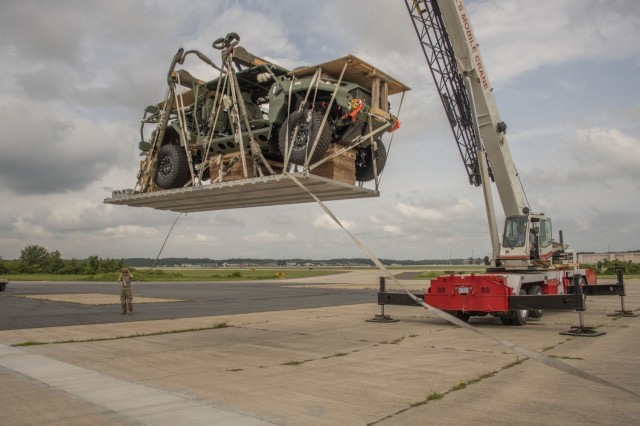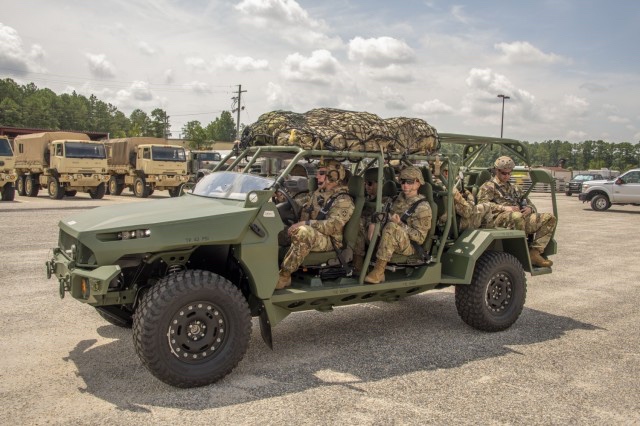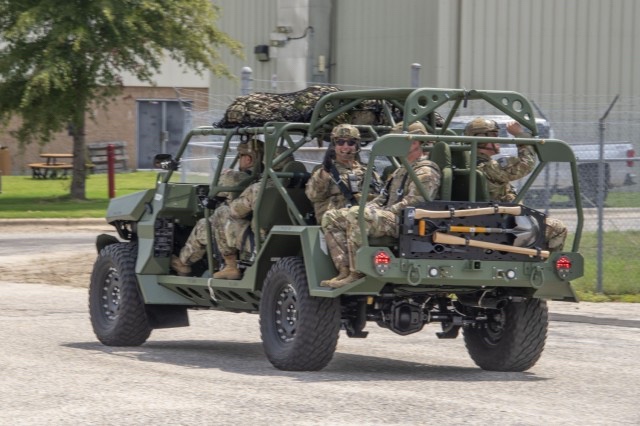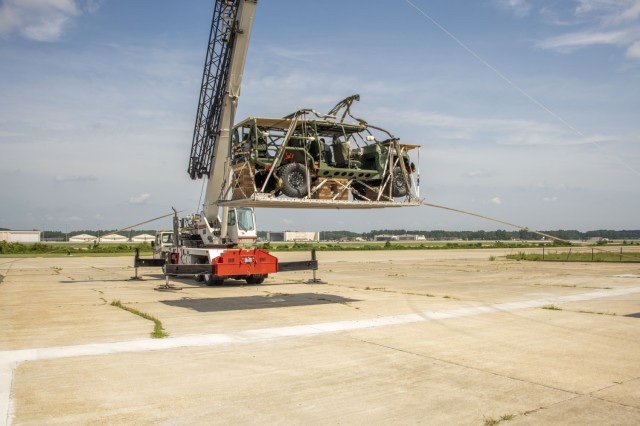FORT BRAGG, North Carolina — Airborne equipment testers here are working with aerospace engineers on modifying airdrop rigging techniques because of structural and mechanical changes made by the manufacture of the Infantry Squad Vehicle (ISV).
“Testing centered around determining if production representative mode (PRM) ISVs could tolerate the forces experienced during low velocity airdrop operations (LVAD),” said Lt. Col. Derek Johnson, Chief of Test Division at the Airborne and Special Operations Test Directorate (ABNSOTD).

The ISV is a new concept to allow Army Infantry Brigade Combat Team Soldiers to cover large areas of challenging terrain more quickly and less fatigued by reducing the area usually covered on foot.
Infantrymen would also be able to carry enough personal and squad provisions to self-sustain for several days, and the ISV is also transported easily by air assets during air assault and airborne assault missions.

The U.S. Army Combat Capabilities Development Command Soldier Center in Natick, Massachusetts assisted ABNSOTD in modifying the ISV rigging procedures and paperboard honeycomb kit to accommodate changes to the production representative model of the ISV by General Motors Defense.
“This capability is required across the range of military operations facing Infantry Brigade Combat Teams conducting crisis response, initial entry, and selected decisive action missions,” said James Cochran (JC), a seasoned Military Test Plans Analyst within ABNSOTD.
Johnson said the changes were deemed necessary after a previous version of the ISV encountered material problems during developmental testing when it was discovered some vehicle components were insufficiently ruggedized for long term vehicle service.

Testing started with a rigging exercise of two PRM ISVs on one standard Type V low velocity airdrop operations (LVAD) platform and one Dual Row Airdrop System platform.
Once rigging solutions and paperboard honeycomb modifications were incorporated into the rigging procedures, both vehicles underwent Simulated Airdrop Impact Testing (SAIT).
The two PRM ISVs rigged on airdrop platforms were raised by crane and free dropped to simulate the impact velocity experienced during LVAD operations.

“During the execution of the SAITs, high-speed video, photography, and instrumentation (accelerometers and impact data recorders) were employed to assess the PRM ISV’s reaction to the forces experienced during LVAD operations,” said Michael Estremera, Electronics Engineer at ABNSOTD.
After SAIT, both vehicles were thoroughly inspected by ABNSOTD, General Motors Defense, and the ISV Program Office to see if either ISV had any damage from forces experienced during the simulated drop.
The testing culminated with a 50-kilometer road test, with ABNSOTD personnel operating the PRM ISVs on improved, semi-improved, and un-improved roads as well as off-road routes at various speeds.
Following road testing, ABNSOTD, General Motors Defense and ISV Program Office personnel thoroughly inspected both vehicles to assess any damage the vehicles may have sustained.
This follow-on testing generated data on the ability of a PRM ISV to withstand the forces experienced during LVAD operations and remain fully mission capable.
“Operating the ISV is a great experience from the driver’s point of view,” said Staff Sergeant Clinton Martinez, an ABNSOTD Parachute Rigger. “It rides smoothly over all types of terrain and visibility is outstanding.”
“The speed and maneuverability of the ISV, along with its capability to easily negotiate all types of terrain should impart confidence in the Infantrymen that will be utilizing this vehicle in real world and training operations,” said Sgt. 1st Class Marcus Love, an Infantryman assigned to ABNSOTD.”
The ISV is deployable worldwide by sea, air, and land to support strategic deployment and operational maneuver in accordance with Army and Joint doctrine.
Story by Mr. Blake Bagby, Military Test Plans Analyst, Airborne and Special Operations Test Directorate, U.S. Army Operational Test Command
Photos by Mr. Michael Zigmond, Photographer, Airborne and Special Operations Test Directorate


Looks so cool! Reminds me of a GI JOE vehicle/toys from the early 80’s!
I’m thinking maybe this testing should have been accomplished prior to selection and acceptance.
I mean one of the program requirements was that the damn things were going to be thrown out of airplanes.
IIRC there have only been prototypes delivered for field testing troop trials. There hasn’t been an official adoption or production contract awarded yet.
So this makes sense. First try them out in the field and see if they can really add any capability, before investing in the expense and challenges of ruggedizing them and figuring out how to make them droppable too.
No sense in taking them into the air if they couldn’t first do the job on the ground.
90s RSOV vibes…
Getting some great use out of them, the Flyers and side-by-sides the units have already had.
Wish we had ’em back in the day for mobility.
••• Having no doors sucks.
••• 1/3 windshield is so dumb.
••• No roof sucks but not as bad as no doors.
Anyone who thinks it looks cool is correct.
Anyone who would wanna roll out the gate with this vehicle in the winter on a cold rainy day is in store for a rude awakening.
Walking from the DZ to the objective sucks more.
Big Red,
Having doors suck – if you need to unass 9 Pax on or near a contested objective fast. Really nice to have 360 visibility and security during the entire process too.
Doors, sides, and roof sucks – if you need to mount up 9 Pax and gear to get off said objective asap. And all pax can still engage threats 360 as well.
We ran jeeps, M151s, without tops, doors or windshields all the time. That was the standard. Same for the HMMWVs. We took the doors off of even the M966 hardtops (TOW Carriers) for the same reason. And the RSOV as Brando mentioned never had them.
I was the Project Officer for the first generation of the GMV. No doors or windshields were considered for those either for all the reasons stated above.
Dealing with rain and cold doesn’t outweighed the tactical advantages of the open concept for the mission profile these vehicles are designed to address.
TLB